Firm Readiness Level for Innovation Projects: A New Decision-Making Tool for Innovation Managers
Abstract
:1. Introduction
2. Overview of the Literature
2.1. Innovation Project Management
2.2. Best Practices in Innovation Projects
- Project Team: Ability of the project manager (mainly) to conduct the project development.
- Project process: Analysis of the information flow around the project.
- Financial structure: Evaluation of the financial values.
- Company: Analysis of the potential impact of the project on the organization.
- Market: Evaluation of the conditions for market access.
3. Methodology for Readiness Evaluation
3.1. Stage 1: Project Characterization According to Its Complexity
3.2. Stage 2: Technological System Components
3.3. Stage 3: Project Impact Assessment
3.4. Stage 4: Requirement Profile Definition
4. Two Illustrative Case Studies: Innovative Projects in Different Firm Contexts
4.1. Case Study 1: Project A
4.2. Case Study 2: Project B
5. Conclusions
- It gives a holistic vision of the project impacts, beyond the pure technical product features.
- It allows a better comprehension of the company’s technological system and the way to manage it.
- It could provide communication elements to the company team, about the impacts and challenges on the new project’s appropriation by the firm.
Acknowledgments
Author Contributions
Conflicts of Interest
References
- AFNOR. 2013. FD X50-271—Management de l’innovation—Guide de mise en œuvre d’une démarche de management de l’innovation. La Plaine Saint-Denis Cedex: AFNOR Editions. [Google Scholar]
- Antunes, Pedro, Paulo Carreira, and Miguel Mira da Silva. 2014. Towards an energy management maturity model. Energy Policy 73: 803–14. [Google Scholar] [CrossRef]
- Artto, Karlos, Iiro Kulvik, Jarno Poskela, and Virpi Turkulainen. 2011. The integrative role of the project management office in the front end of innovation. International Journal of Project Management 29: 408–21. [Google Scholar] [CrossRef]
- Atalay, Murat, Nilgün Anafarta, and Fulya Sarvan. 2013. The Relationship between Innovation and Firm Performance: An Empirical Evidence from Turkish Automotive Supplier Industry. Procedia 75: 226–35. [Google Scholar] [CrossRef]
- Batkovskiy, Aleksandr Mihajlovich, Alina Valerevna Konovalova, Elena Georgievna Semenova, Valerij Yaroslavovich Trofimets, and Alena Vladimirovna Fomina. 2015. Risks of Development and Implementation of Innovative Projects. Mediterranean Journal of Social Sciences 6: 243. [Google Scholar] [CrossRef]
- Besner, Claude, and Brian Hobbs. 2012. An Empirical Identification of Project Management Toolsets and a Comparison among Project Types. Project Management Journal 43: 24–46. [Google Scholar] [CrossRef]
- Boly, Vincent, Laure Morel, and Mauricio Camargo. 2012. Improving performance evaluation metrics to manage innovative projects. International Journal of Technology Intelligence and Planning 8: 215–32. [Google Scholar] [CrossRef]
- Boly, Vincent, Laure Morel, N’Doli Guillaume Assielou, and Mauricio Camargo. 2014. Evaluating innovative processes in French firms: Methodological proposition for firm innovation capacity evaluation. Research Policy 43: 608–22. [Google Scholar] [CrossRef]
- Boly, Vincent, Mauricio Camargo, Daniel Galvez, and Johan Claire. 2015. How to Adapt the Innovation Process to the Context and Objectives of the Project. Paper presented at International Association for Management of Technology (IAMOT), Cape Town, South Africa, June 8–11. [Google Scholar]
- Boly, Vincent, Mauricio Camargo, and Laure Morel. 2016. Ingénierie de l’innovation, 3rd ed. Paris: Hermes Science Publications. [Google Scholar]
- Brook, Jacques W., and Fabrizio Pagnanelli. 2014. Integrating sustainability into innovation project portfolio management—A strategic perspective. Journal of Engineering and Technology Management 34: 46–62. [Google Scholar] [CrossRef]
- Candi, Marina, Jan van den Ende, and Gerda Gemser. 2013. Organizing innovation projects under technological turbulence. Technovation 33: 133–41. [Google Scholar] [CrossRef]
- Christiansen, John K., and Marta Gasparin. 2016. Managing Controversies in the Fuzzy Front End. Creativity and Innovation Management 25: 500–14. [Google Scholar] [CrossRef]
- Claire, Johan, Daniel Galvez, Vincent Boly, Mauricio Camargo, and Johan Claire Moselle. 2014. A New Innovation Project Maturity Assessment Methodology Based on Innovation Degree. Paper presented at 2014 International Conference on Engineering, Technology and Innovation (ICE), Bergamo, Italy, June 23–25; pp. 1–8. [Google Scholar]
- Cooper, Robert G. 1990. Stage-gate systems: A new tool for managing new products. Business Horizons 33: 44–54. [Google Scholar] [CrossRef]
- Cooper, Robert G. 2008. Perspective: The Stage-Gate® Idea-to-Launch Process—Update, What’s New and NexGen Systems. Journal of Product Innovation Management 25: 213–32. [Google Scholar] [CrossRef]
- Cooper, Robert G. 2016. Agile–Stage-Gate Hybrids. Research-Technology Management 59: 21–9. [Google Scholar] [CrossRef]
- De Wit, Anton. 1988. Measurement of project success. International Journal of Project Management 6: 164–70. [Google Scholar] [CrossRef]
- Eriksson, Per Erik, Johan Larsson, and Ossi Pesämaa. 2017. Managing complex projects in the infrastructure sector—A structural equation model for flexibility-focused project management. International Journal of Project Management 35: 1512–23. [Google Scholar] [CrossRef]
- Fernandes, Gabriela, Stephen Ward, and Madalena Araújo. 2015. Improving and embedding project management practice in organisations—A qualitative study. International Journal of Project Management 33: 1052–67. [Google Scholar] [CrossRef]
- Garcia, Rosanna, and Roger Calantone. 2002. A critical look at technological innovation typology and innovativeness terminology: A literature review. Journal of Product Innovation Management 19: 110–32. [Google Scholar] [CrossRef]
- García-Quevedo, José, Agustí Segarra-Blasco, and Mercedes Teruel. 2018. Financial constraints and the failure of innovation projects. Technological Forecasting and Social Change 127: 127–40. [Google Scholar]
- Godet, Michel. 2007. Manuel de prospective stratégique—Tome 2—3ème edition—L’Art et la méthode, 3rd ed. Paris: Editions Dunod. [Google Scholar]
- Kapsali, Maria. 2011. Systems thinking in innovation project management: A match that works. International Journal of Project Management 29: 396–407. [Google Scholar] [CrossRef]
- Larson, Erik W., and Clifford F. Gray. 2011. Project Management: The Managerial Process. New York: McGraw-Hill Irwin. [Google Scholar]
- Maier, Anja M., James Moultrie, and P. John Clarkson. 2012. Assessing Organizational Capabilities: Reviewing and Guiding the Development of Maturity Grids. IEEE Transactions on Engineering Management 59: 138–59. [Google Scholar] [CrossRef]
- Mintzberg, Henry. 1979. The Structuring of Organizations. Englewood Cliffs: Pearson. [Google Scholar]
- Mitchell, Rick, Robert Phaal, and Nicky Athanassopoulou. 2014. Scoring Methods for Prioritizing and Selecting Innovation Projects. Paper presented at PICMET ‘14 Conference: Portland International Center for Management of Engineering and Technology, Kanazawa, Japan, July 27–31; pp. 907–20. [Google Scholar]
- Morel, Laure, Mauricio Camargo, and Vincent Boly. 2015. Comment réussir le pilotage d’un projet d’innovation dans une PME/PMI. In le Grand Livre de l’Économie PME. Paris: LGDJ. [Google Scholar]
- Mortensen, Peter Stendahl, and Carter Walter Bloch. 2005. Oslo Manual: Guidelines for Collecting and Interpreting Innovation Data, 3rd ed. Paris: OECD Publishing. [Google Scholar]
- Project Management Institute. 2017. A Guide to the Project Management Body of Knowledge, 6th ed. Newtown Square: Project Management Institute. [Google Scholar]
- Radujković, Mladen, and Mariela Sjekavica. 2017. Project Management Success Factors. Procedia Engineering 196: 607–15. [Google Scholar]
- Rosenbusch, Nina, Jan Brinckmann, and Andreas Bausch. 2011. Is innovation always beneficial? A meta-analysis of the relationship between innovation and performance in SMEs. Journal of Business Venturing 26: 441–57. [Google Scholar] [CrossRef] [Green Version]
- Salerno, Mario Sergio, Leonardo Augusto de Vasconcelos Gomes, Débora Oliveira da Silva, Raoni Barros Bagno, and Simone Lara Teixeira Uchôa Freitas. 2015. Innovation processes: Which process for which project? Technovation 35: 59–70. [Google Scholar] [CrossRef]
- San Cristóbal, José Ramón. 2017. Complexity in Project Management. Procedia Computer Science 121: 762–66. [Google Scholar]
- Santos, David Ferreira Lopes, Leonardo Fernando Cruz Basso, Herbert Kimura, and Eduardo Kazuo Kayo. 2014. Innovation efforts and performances of Brazilian firms. Journal of Business Research 67: 527–35. [Google Scholar] [CrossRef]
- Schulz, Jörn, Fee Steinhoff, and Kathrin Jepsen. 2017. Strike While the Iron Is Hot: User Centricity Adapted to the Agile Innovation Development Process. Cham: Springer, pp. 349–65. [Google Scholar]
- Schumpeter, Joseph A. 1934. The Theory of Economic Development: An Inquiry Into Profits, Capital, Credit, Interest, and the Business Cycle. Piscataway: Transaction Publishers. [Google Scholar]
- Takeuchi, Hirotaka, and Ikujiro Nonaka. 1986. The New New Product Development Game. Harvard Business Review. Available online: https://hbr.org/1986/01/the-new-new-product-development-game (accessed on 9 March 2018).
- Talke, Katrin, Sören Salomo, Jaap E. Wieringa, and Antje Lutz. 2009. What about design newness? Investigating the relevance of a neglected dimension of product innovativeness. Journal of Product Innovation Management 26: 601–15. [Google Scholar]
- Tripp, John F., and Deborah J. Armstrong. 2016. Agile Methodologies: Organizational Adoption Motives, Tailoring and Performance. Journal of Computer Information Systems 58: 170–79. [Google Scholar] [CrossRef]
- Wendler, Roy. 2012. The maturity of maturity model research: A systematic mapping study. Information and Software Technology 54: 1317–39. [Google Scholar] [CrossRef]
- Zawislak, Paulo Antônio, Jorge Tello Gamarra, André Cherubini Alves, Denise Barbieux, and Fernanda Maciel Reichert. 2014. The different innovation capabilities of the firm: Further remarks upon the Brazilian experience. Journal of Innovation Economics & Management 1: 129–50. [Google Scholar]
- Zhang, Lianying, Jing He, and Xinxing Zhang. 2012. The Project Management Maturity Model and Application Based on PRINCE2. Procedia Engineering 29: 3691–97. [Google Scholar]
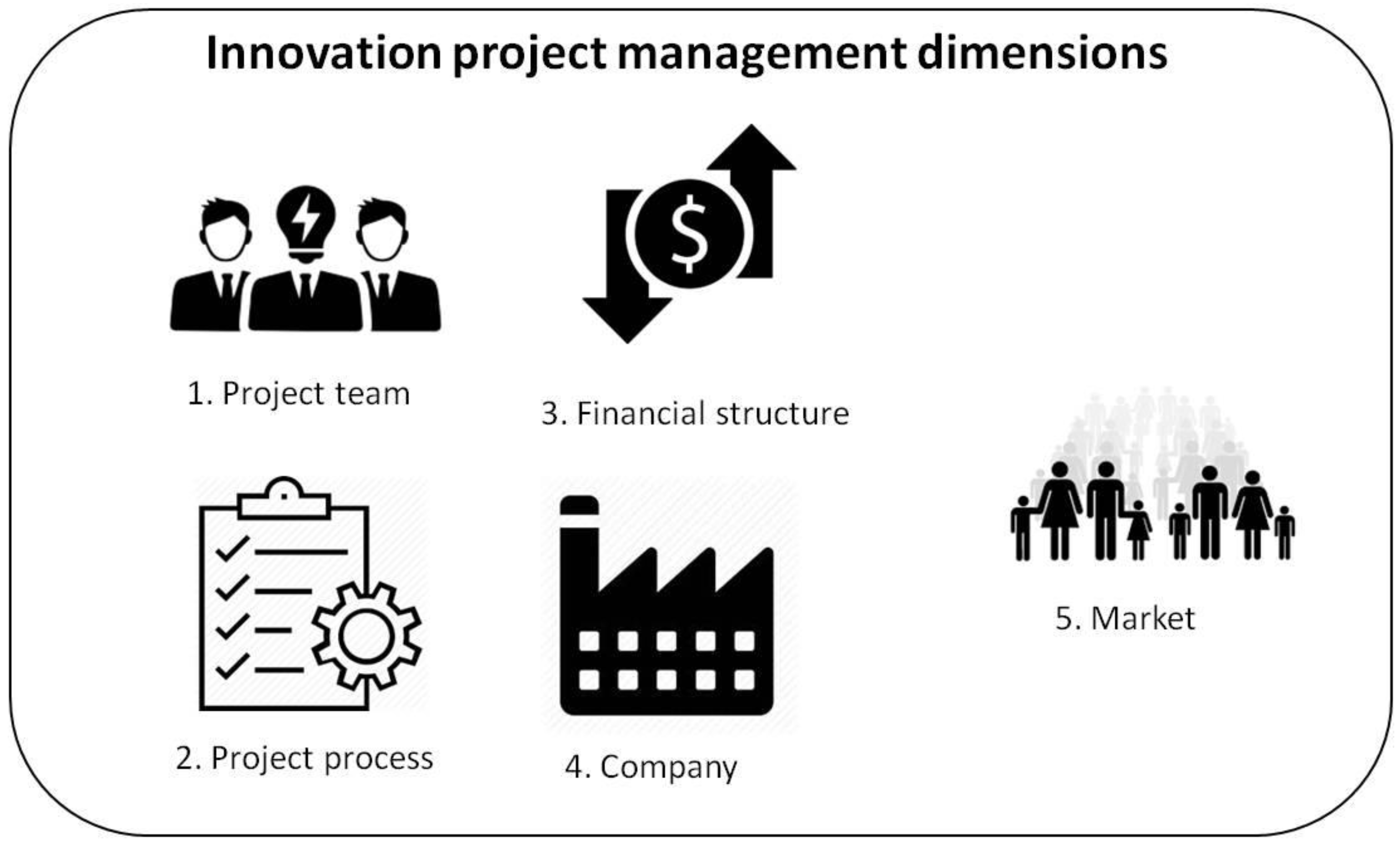
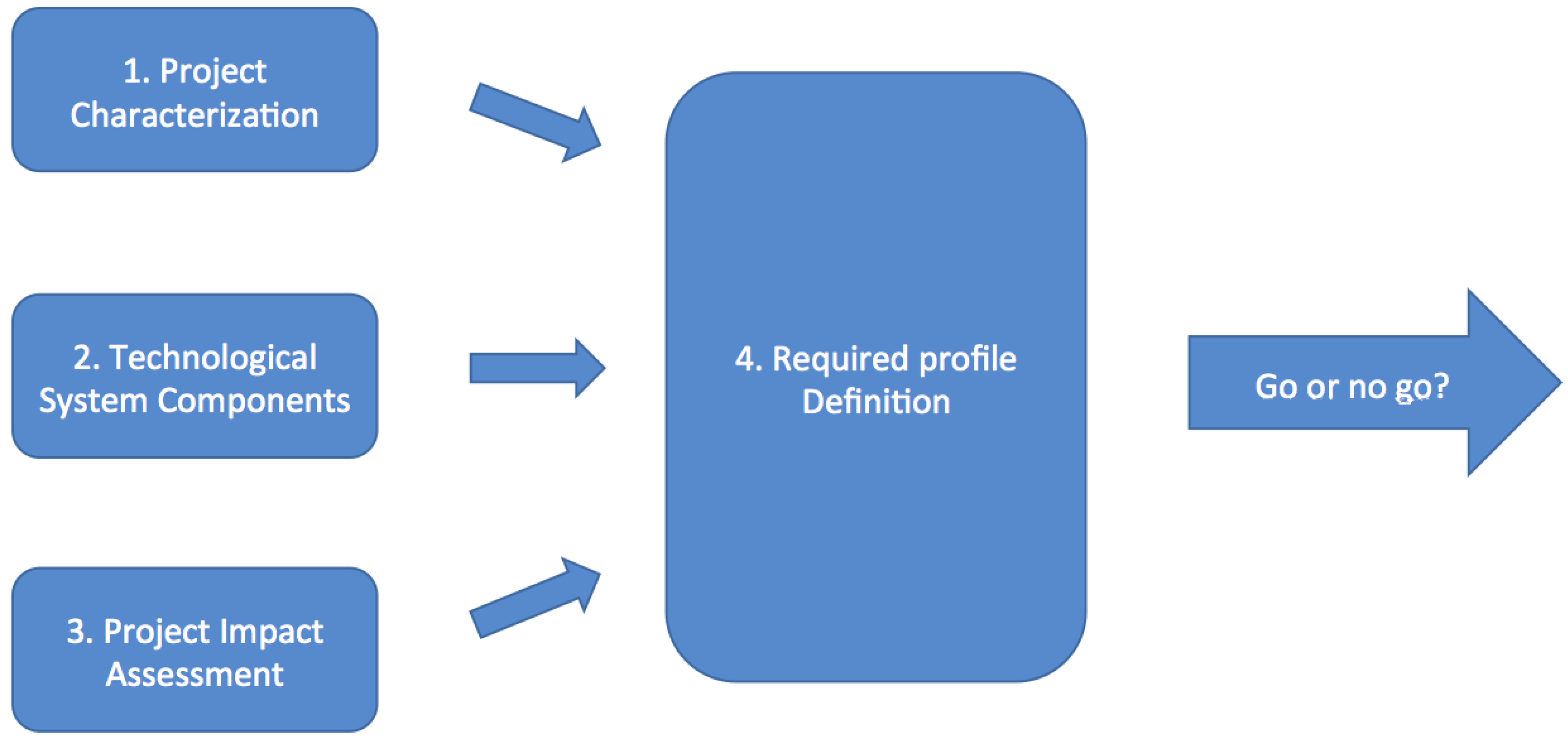
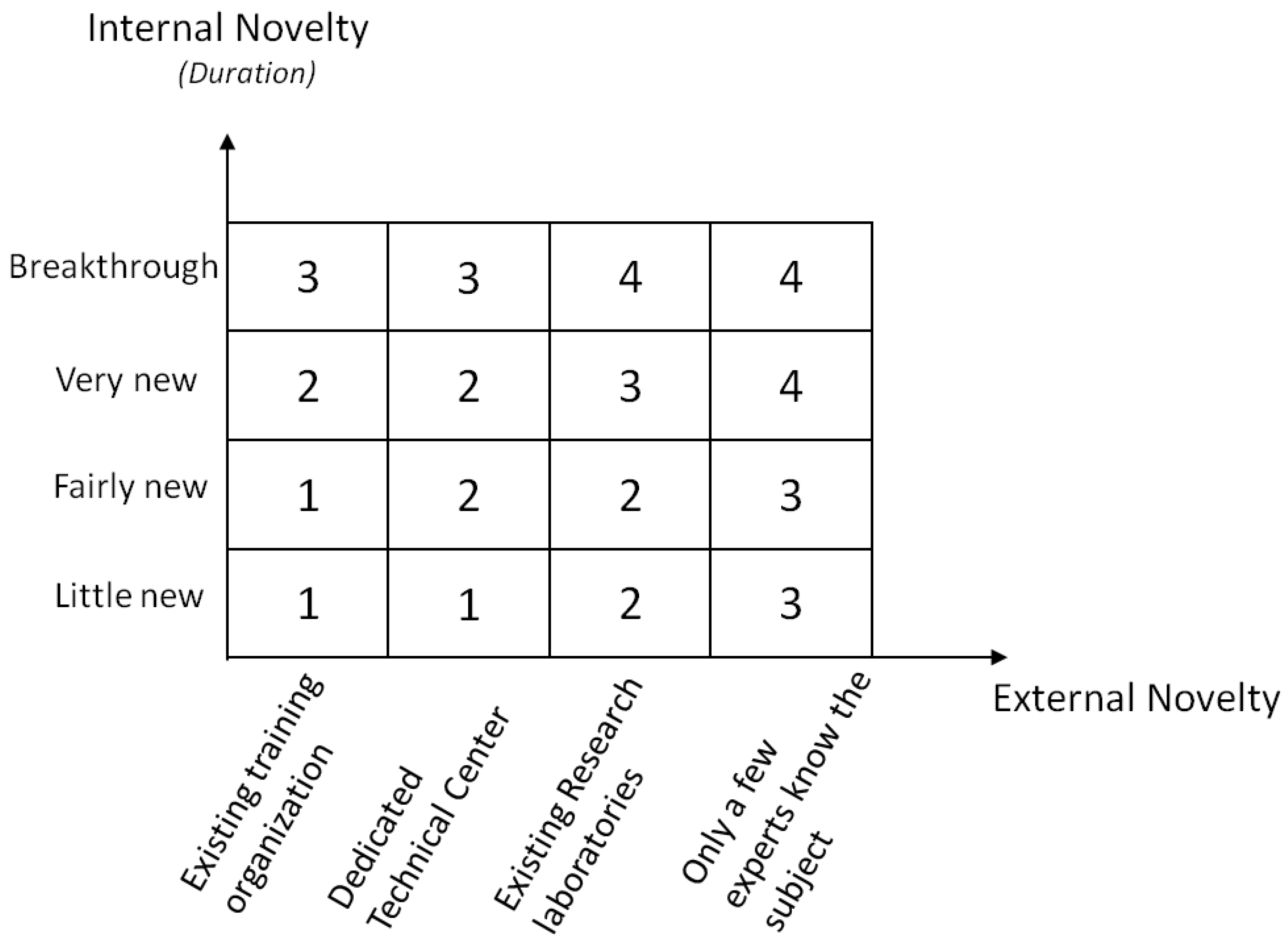
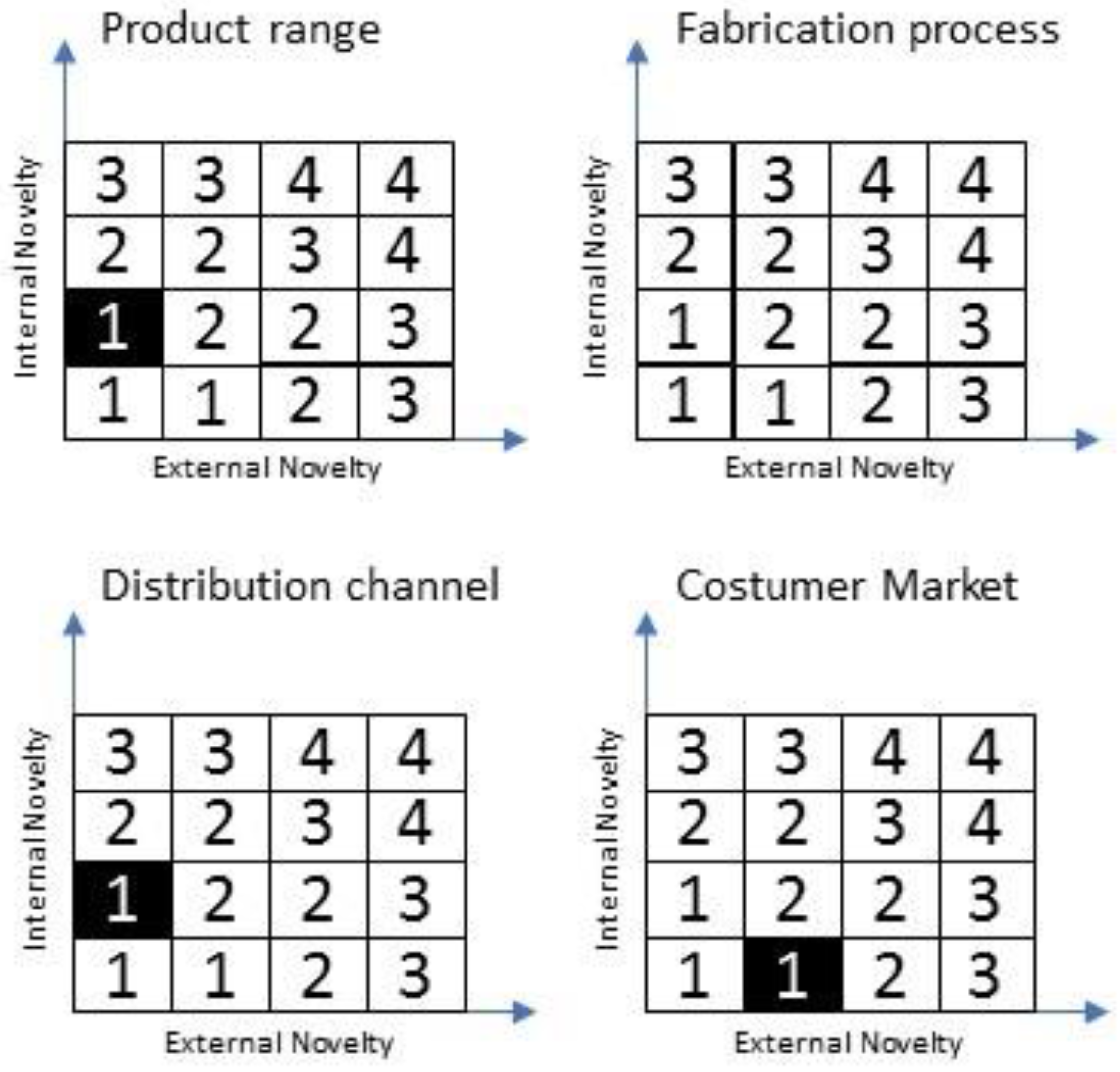
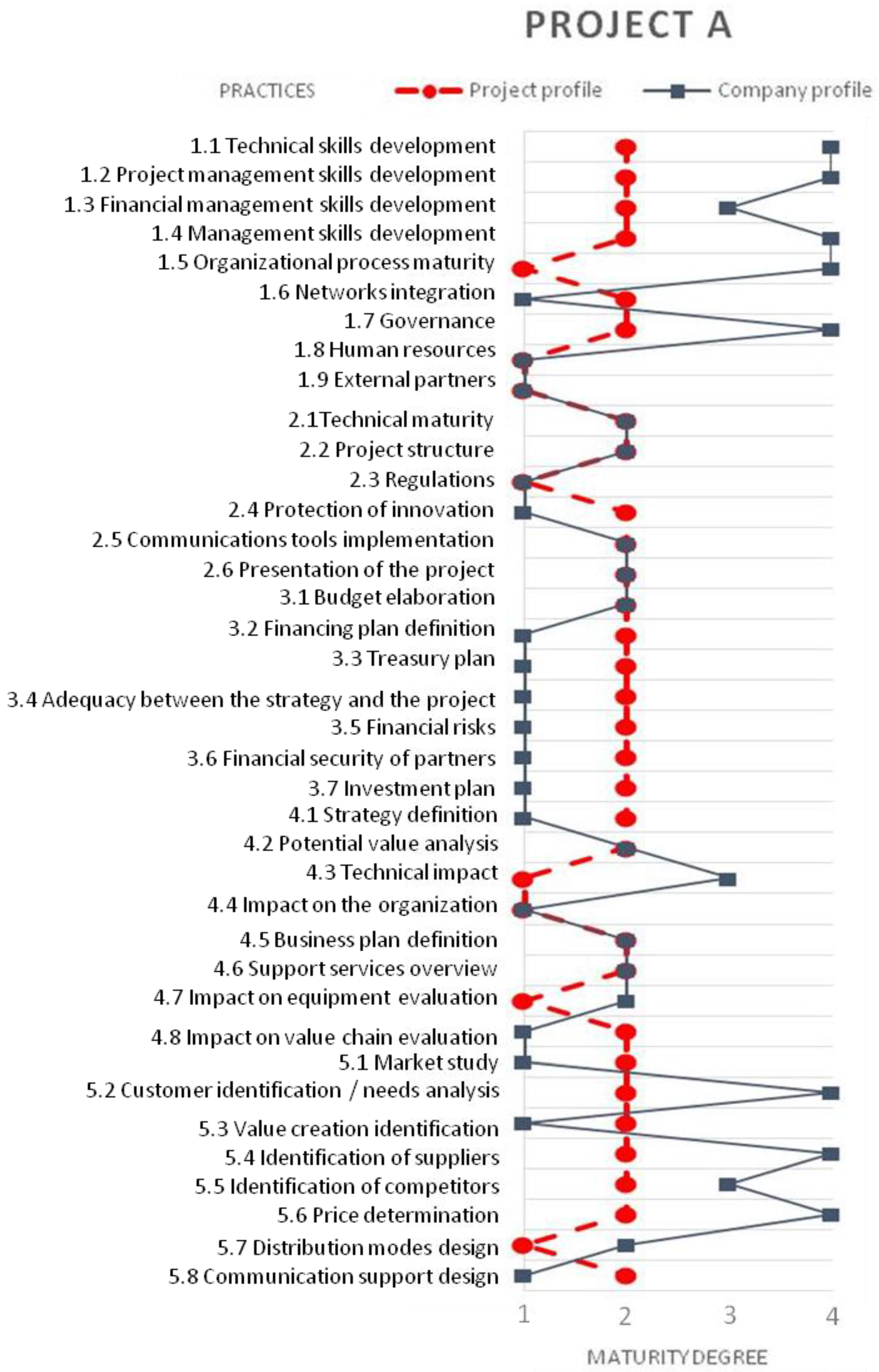
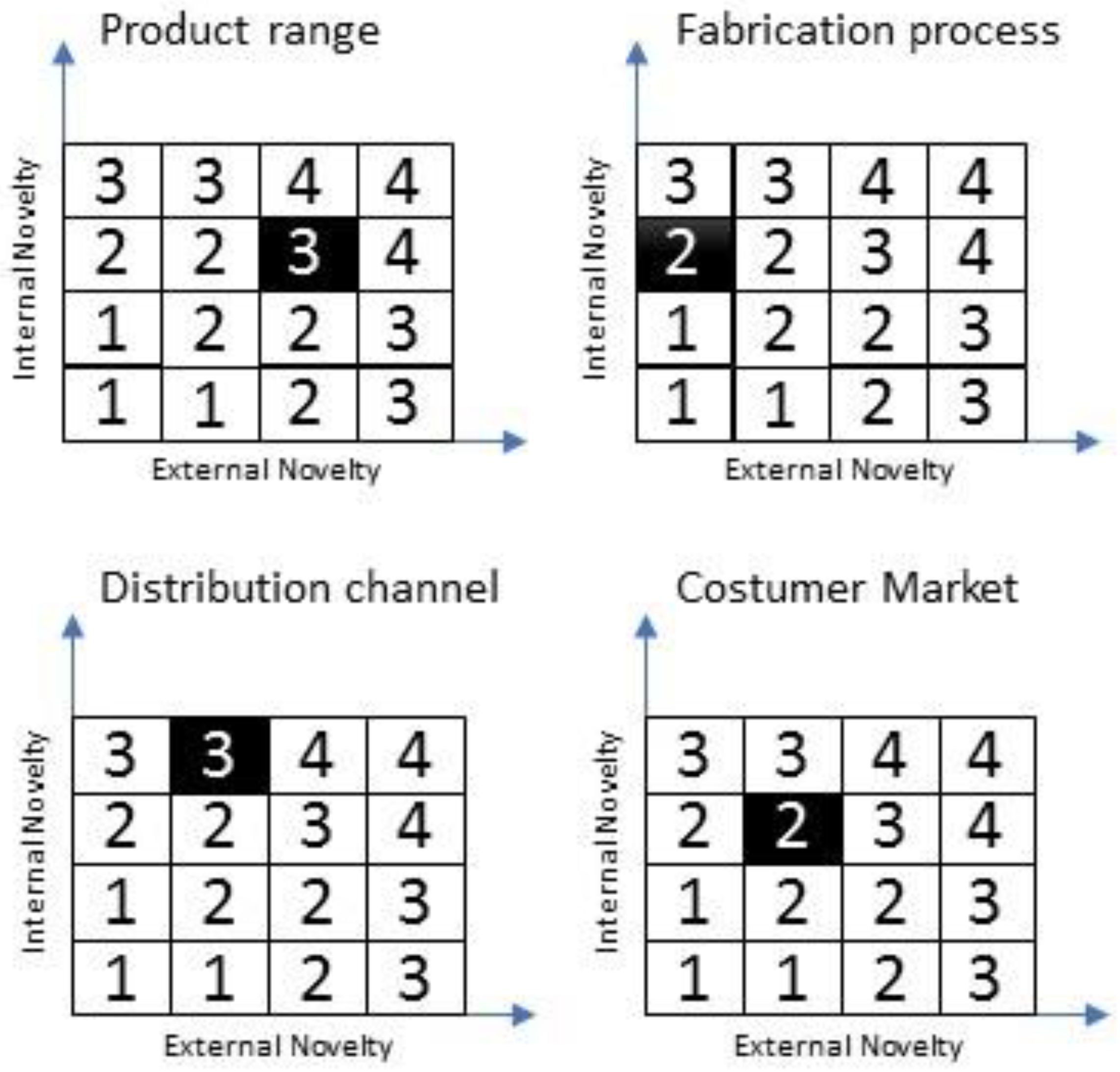

| Project Formulation | Project Feasibility | Innovation Development | Innovation Launch | |
|---|---|---|---|---|
| Marketing | Ca1/Position the project launched in relation to the needs identified by the innovation | Cb1/Identify the usage scenarios | Cc1/Validate the adequacy of innovation to needs | Cd1/Confirm value creation goals |
| Technology | Ca2/Make the state of the art and identify the solutions for the project | Cb2/Study the technical feasibility | Cc2/Develop the technical solution | Cd2/Qualify innovation and its implementation |
| Legislative/financing | Ca3/Define intellectual property strategy and financial strategy | Cb3/Put in place funding and test partnerships | Cc3/Ensure the legal and financial management of the project | Cd3/Finalize Intellectual property and innovation financing |
| Organization/Management | Ca4/Formulate/structure the launched project | Cb4/Organize the project | Cc4/manage the innovation development | Cd4/Supervise the innovation launch |
| Practice 5.5: Identification of competitors | Level 1 | Level 2 | Level 3 | Level 4 |
| The competitors are not known | The competitors are identified | The competitors are identified and pose a moderate risk that has been assessed with measurable criteria | A monitoring system is set up |
| If One Variable Is Affected | If Two Variables Are Affected | If Three Variables Are Affected | If Four Variables Are Affected | |
|---|---|---|---|---|
| Complementary complexity index (CCI) | 0 | 2 | 3 | 4 |
| Global Impact Index | [0; 4] | [4; 8] | [8; 12] | [12; 20] |
|---|---|---|---|---|
| Project requirement level | 1 | 2 | 3 | 4 |
© 2018 by the authors. Licensee MDPI, Basel, Switzerland. This article is an open access article distributed under the terms and conditions of the Creative Commons Attribution (CC BY) license (http://creativecommons.org/licenses/by/4.0/).
Share and Cite
Galvez, D.; Enjolras, M.; Camargo, M.; Boly, V.; Claire, J. Firm Readiness Level for Innovation Projects: A New Decision-Making Tool for Innovation Managers. Adm. Sci. 2018, 8, 6. https://doi.org/10.3390/admsci8010006
Galvez D, Enjolras M, Camargo M, Boly V, Claire J. Firm Readiness Level for Innovation Projects: A New Decision-Making Tool for Innovation Managers. Administrative Sciences. 2018; 8(1):6. https://doi.org/10.3390/admsci8010006
Chicago/Turabian StyleGalvez, Daniel, Manon Enjolras, Mauricio Camargo, Vincent Boly, and Johan Claire. 2018. "Firm Readiness Level for Innovation Projects: A New Decision-Making Tool for Innovation Managers" Administrative Sciences 8, no. 1: 6. https://doi.org/10.3390/admsci8010006





